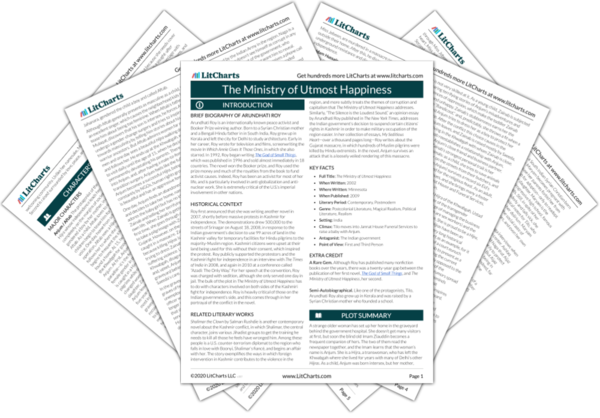Corruption, Political Violence, and Capitalism
The Ministry of Utmost Happiness paints a portrait of contemporary, postcolonial Indian politics. Through the differing points of view of the story’s characters, Arundhati Roy illustrates the many ways in which various groups of the Indian population have been let down and oppressed by their political leaders after the 1947 partition between India and Pakistan. In particular, through her illustration of the ongoing Kashmir conflict between these two countries, she highlights corruption in all political…
read analysis of Corruption, Political Violence, and CapitalismResilience and Hope
While The Ministry of Utmost Happiness paints, on the whole, a relatively bleak portrait of politics and violence in modern India, resilience and hope among the characters is an important thread throughout the work. In the novel, Roy addresses social inequalities, political corruption, and a great deal of violence through the points of view of various characters. However, she also highlights the history of hope and resistance in India, and the characters’ resilience in the…
read analysis of Resilience and HopeGender Identity, Social Division, and Coexistence
The first half of The Ministry of Utmost Happiness is told through the point of view of Anjum, a transgender woman and former sex worker who was born intersex—with both female and male genitalia. (Her mother gendered Anjum a boy and named him Aftab, and he/him/his pronouns are used to refer to Aftab at the beginning of his life before he starts identifying as a trans woman.) Through Anjum’s eyes, readers are exposed to…
read analysis of Gender Identity, Social Division, and Coexistence
Religion and Power
The Ministry of Utmost Happiness addresses a wide range of issues facing contemporary Indian society. Among these various struggles, one of the most salient is religion: much of the violence that the characters observe and experience in the novel stems from conflicts between Hindus and Muslims. Roy demonstrates the ways in which religious extremism in both faiths leads to greater violence and intolerance in India. In doing so, she highlights the danger in allowing religious…
read analysis of Religion and Power







Social Hierarchy vs. Social Inclusivity
One of the most salient aspects of contemporary Indian society that comes across in The Ministry of Utmost Happiness is a rigid social hierarchy, maintained principally by the caste system but also upheld by religious differences. While the conservative characters in the novel seek to uphold the hierarchy that privileges them, the oppressed and marginalized characters continuously fight for greater equality in their society. By demonstrating the difference between the characters that believe in hierarchy…
read analysis of Social Hierarchy vs. Social Inclusivity